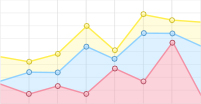|
[1]
|
M.A. Aziz-Alaoui, Study of a Leslie-Gower-type tritrophic population model, Chaos, Solitons and Fractals, 14(2002), 1275-1293.
Google Scholar
|
|
[2]
|
Q. Bie and R. Peng, Qualitative Analysis on a Reaction-Diffusion PreyPredator Model and the Corresponding Steady-States, Chin. Ann. Math., 30B(2) (2009), 207-220.
Google Scholar
|
|
[3]
|
M. Baurmann, T. Gross and U. Feudel, Instabilities in spatially extended predator prey systems:Spatio-temporal patterns in the neighborhood of TuringHopf bifurcations, Journal of Theoretical Biology, 245(2007), 220-229.
Google Scholar
|
|
[4]
|
W. Chen and M. Wang, Positive Steady States of a Competitor-CompetitorMutualist Model, Acta Mathematicae Applicatae Sinica, English Series, 20(2004), 53-58.
Google Scholar
|
|
[5]
|
F. Chen, L. Chen and X. Xie, On a Leslie-Gower predator-prey model incorporating a prey refuge, Nonlinear Analysis:Real World Applications, 10(2009), 2905-2908.
Google Scholar
|
|
[6]
|
S. Gakkhar and B. Singh, Complex dynamic behavior in a food web consisting of two preys and a predator, Chaos, Solitons and Fractals 24(2005), 789-801.
Google Scholar
|
|
[7]
|
S. Gakkhar and B. Singh, Dynamics of modified Leslie-Gower-type preypredator model with seasonally varying parameters, Chaos, Solitons and Fractals, 27(2006), 1239-1255.
Google Scholar
|
|
[8]
|
S. Gakkhar and R.K. Naji, Existence of chaos in two-prey, one-predator system, Chaos, Solitons and Fractals, 17(2003), 639-649.
Google Scholar
|
|
[9]
|
S. Gakkhar and R.K. Naji, Order and chaos in a food web consisting of a predator and two independent preys, Communications in Nonlinear Science and Numerical Simulation, 10(2005) 105-120.
Google Scholar
|
|
[10]
|
L.-J. Hei and Y. Yu, Non-constant steady state of one resource and two consumers model with diffusion, J. Math. Anal. Appl., 339(2008), 566-581
Google Scholar
|
|
[11]
|
D. Henry, Geometric Theory of Semilinear Parabolic Equations, Lecture Notes in Math., vol. 840, Edited by A. Dold and B. Eckmann, Springer-Verlag, Berlin, 1981.
Google Scholar
|
|
[12]
|
W. Ko and I. Ahn, Analysis of ratio-dependent food chain model, J. Math. Anal. Appl., 335(2007), 498-523
Google Scholar
|
|
[13]
|
W. Ko and K. Ryu, Non-constant positive steady-states of a diffusive predatorprey system in homogeneous environment, J. Math. Anal. Appl., 327(2007), 539-549.
Google Scholar
|
|
[14]
|
S. Lv and M. Zhao, The dynamic complexity of a three species food chain model, Chaos, Solitons and Fractals, 37(2008), 1469-1480.
Google Scholar
|
|
[15]
|
Y. Lou and W.-M. Ni, Diffusion, self-diffusion and cross-diffusion, J. Differential Equations, 131(1996), 79-131.
Google Scholar
|
|
[16]
|
Y. Lou and W.-M. Ni, Diffusion vs cross-diffusion:An elliptic approach, J. Differential Equations, 154(1999), 157-190.
Google Scholar
|
|
[17]
|
A.F. Nindjin, M.A. Aziz-Alaoui and M. Cadivel, Analysis of a predator-prey model with modified Leslie-Gower and Holling-type Ⅱ schemes with time delay, Nonlinear Analysis:Real World Applications, 7(2006), 1104-1118.
Google Scholar
|
|
[18]
|
L. Nirenberg, Topics in Nonlinear Functional Analysis, American Mathematical Society, Providence, RI, 2001.
Google Scholar
|
|
[19]
|
P.Y.H. Pang and M. Wang, Strategy and stationary pattern in a three-species predator-prey model, J. Differential Equations, 200(2004), 245-273.
Google Scholar
|
|
[20]
|
P.Y.H. Pang and M. Wang, Qualitative analysis of a ratio-dependent predatorprey system with diffusion, Proc. Roy. Soc. Edinburgh A, 133(4) (2003), 919-942.
Google Scholar
|
|
[21]
|
P. Rui and W. Mingxin, Qualitative analysis on a diffusive prey-predator model with ratio-dependent functional response, Science in China Series A:Mathematics, 51(2008), 2043-2058.
Google Scholar
|
|
[22]
|
H.-Bo Shi, W.-T. Li and G. Lin, Positive steady states of a diffusive predatorprey system with modified Holling-Tanner functional response, Nonlinear Analysis:Real World Applications, 11(2010), 3711-3721.
Google Scholar
|
|
[23]
|
M. Wang, Stationary patterns for a prey-predator model with prey-dependent and ratio-dependent functional responses and diffusion, Physica D:Nonlinear Phenomena, 196(2004), 172-192.
Google Scholar
|
|
[24]
|
W. Wang, Q.-X. Liu and Z. Jin, Spatiotemporal complexity of a ratio-dependent predator-prey system, Physical Review E, doi:10.1103/PhysRevE.75.051913(2007).
Google Scholar
|
|
[25]
|
Z. Wen and C. Zhong, Non-constant positive steady states for the HP food chain system with cross-diffusion, Mathematical and Computer Modelling, 51(2010), 1026-1036.
Google Scholar
|
|
[26]
|
M. Yang and W. Chen, Non-constant Stationary Solutions to a Prey-predator Model with Diffusion, Acta Mathematicae Applicatae Sinica, English Series, 25(2009), 141-150.
Google Scholar
|
|
[27]
|
X. Zenga and Z. Liu, Nonconstant positive steady states for a ratio-dependent predator prey system with cross-diffusion, Nonlinear Analysis:Real World Applications, 11(2010), 372-390.
Google Scholar
|
|
[28]
|
S. Zheng, A Reaction-Diffusion System of a Competitor-Competitor-Mutualist Model, J. Math. Anal. Appl., 124(1987), 254-280.
Google Scholar
|
|
[29]
|
W. Zhou, Positive solutions for a diffusive Bazykin model in spatially heterogeneous environment, Nonlinear Analysis:Theory, Methods and Applications, 73(2010), 922-932.
Google Scholar
|
|
[30]
|
J. Zhou and C. Mu, Coexistence states of a Holling type-Ⅱ predator-prey system, J. Math. Anal. Appl., 369(2010), 555-563.
Google Scholar
|





 DownLoad:
DownLoad: